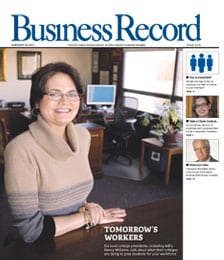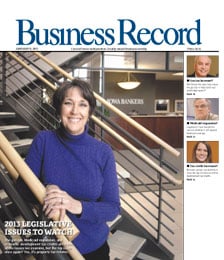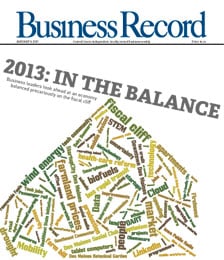Centro practices, twice, at opening

It’s just before 11 a.m. on Wednesday of last week, and Centro, the Italian restaurant in the Temple for Performing Arts, is scheduled to open in moments.
Flames are roaring from the restaurant’s two hand-built brick pizza ovens. Cooks are nearly tripping over one another as they hurriedly make last-minute preparations.
The restaurant isn’t opening to the general public, yet. That happens Friday. Today, two days before its official grand opening, Centro has invited employees from hotels and restaurants in Des Moines to come in for a free lunch.
In return, Centro’s staff gets a practice run serving to what’s likely to be a forgiving audience. In addition, restaurant managers are hoping for critical feedback and tips on how they can improve in the little time they have left before the restaurant opens for real.
Servers are straightening tablecloths that cover each of the restaurant’s 60 or so tables, which cost about $150 apiece. Those tables, which are surrounded by $70 chairs, have been set with roughly $4,000 worth of silverware. The $1 million-plus restaurant owns 260 place settings.
Co-owner Paul Rottenberg pulls general manager John Cimaglia aside, concerned that there are too many tables for four and not enough tables that seat two. He’s also wondering why glasses on the tables – the restaurant owns 21 dozen glasses – have already been filled with water.
“Pre-set waters. Tell me about that,” he says.
Then the pair discuss ways to create more tables for two. Rottenberg believes that if the restaurant’s New York-style pizzas become popular, he will need as many tables for four as the space can handle because families will flock to the restaurant.
But he’s not sure how the pizza will be received. And so the restaurant kitchen staff, led by one of his partners and co-owners, George Formaro, has developed a full and varied menu to cater to those with other tastes.
“That’s the great mystery – what’s the pizza going to do?” he says.
At that moment, another employee approaches Rottenberg, telling him that state inspectors would like to test the building’s fire alarms in 30 minutes – right in the middle of lunch.
Rottenberg says a few words and, evidently, the inspectors agree to postpone their test.
The restaurant, in many ways, centers on pizza. During the year that Centro has been under construction,
Rottenberg and Formaro went to New York several times to study the city’s pizzerias and their ovens. During one visit, the pair ate nothing but pizza for two days. Trying to get a closer look at one pizza place’s ovens, which are guarded jealously, Formaro got himself thrown out.
The pair wanted a Brooklyn-based company to build Centro’s pizza ovens. The estimated bill topped $100,000, so Rottenberg and Formaro looked for another approach. They found it after
Formaro, who also owns the South Union Bread Cafe, said he could adapt the bread ovens in that restaurant for use at Centro. The ovens, capable of producing temperatures over 800 degrees, can cook six pizzas every three minutes.
The floor plan at Centro, which resembles a Macaroni Grill set in a Greenwich Village loft, was designed around the ovens. Next came the kitchens, followed by the bar, which parallels Locust Street.
Other difficulties have cropped up during the restaurant’s construction. Bench seats along the walls were built 21 inches high. They had to be ripped out and rebuilt after the restaurant’s 18-inch-tall chairs arrived.
Wednesday’s trial lunch, the second practice run by the staff, was supposed to have taken place on Tuesday. The lunch had to be postponed because of a mix-up that happened Monday night during the first practice meal.
On that evening, managers had expected 120 friends and family to appear for dinner. Instead, because too many invitations had been sent out, they were inundated with 220 guests.
The kitchen, which opened that night at 6 p.m., served its last meal after 10 p.m., Rottenberg said. There wasn’t any food left to serve for lunch Tuesday.
By 11:30 a.m. on Wednesday, about a half-dozen tables are filled and servers are taking orders. Rottenberg appears relaxed. He has been involved in several start-up restaurants, including Raccoon River Brewing Co. Still, he knows that opening a restaurant is tricky, and never a sure thing.
“You agonize over picking chairs and tables and how you want them to look and how thick they need to be,” he says. “And then you realize that the hard part is now, when you open and are serving customers. This is a huge risk.”







